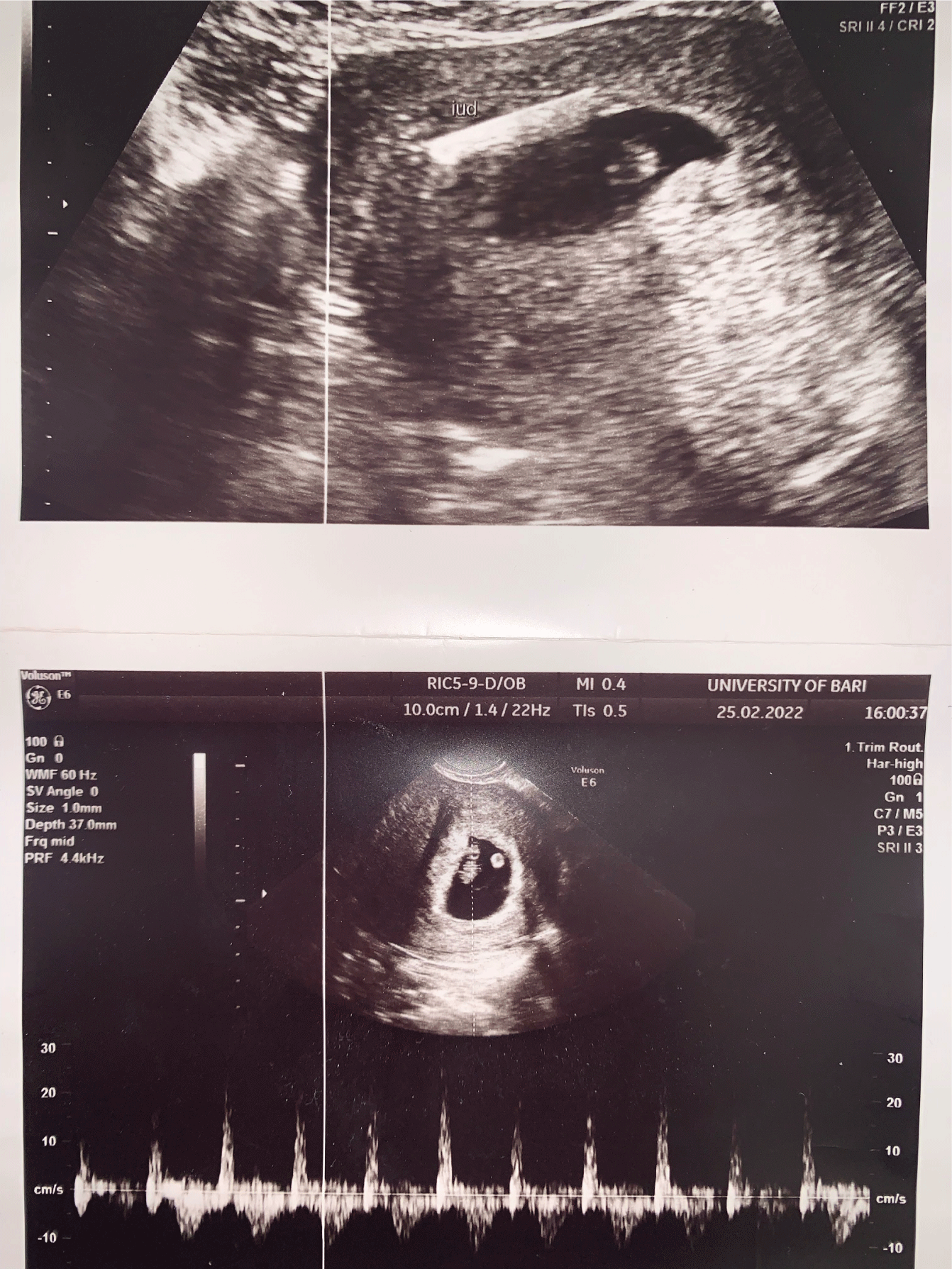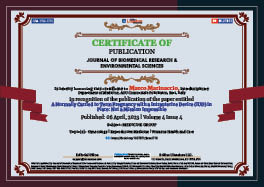Medicine Group . 2023 April 06;4(4):610-613. doi: 10.37871/jbres1716.
A Normally Carried to Term Pregnancy with a Intrauterine Device (IUD) in Place: Not a Mission Impossible
Marinaccio M*, Vitagliano A, Vimercati A, Dellino M, Sanasi A, Cara I, Giannoccaro A, Mastronardi M and Clark C
- Pregnancy
- IUD
- Preterm delivery
- >Intra-uterine device
Abstract
Intracavitary pregnancy with a correctly inserted IUD is a very rare event and can lead to a wide range of complications, mainly in the form of chorioamnionitis and preterm delivery. We present the case of a 39-year old woman who was diagnosed with pregnancy despite the use of an intra-uterine device. After a thorough discussion with her gynecologist over the risks, the patient finally decided to bring the pregnancy to term without removing the device. The pregnancy proceeded without any major complication and the patient finally gave birth to a healthy child. Soon after, another US of the uterine cavity was carried out which showed the device still in position.
Introduction
Intra Uterine Devices (IUDs) are a very popular form of contraception which consist of placing a variously-shaped device inside the uterine cavity, thus preventing sperm cells from reaching the ovulated oocyte. Some kinds of IUD are also coated in hormones which further reduce the chance of a pregnancy occurring by rendering the endometrium uncapable of being invaded by the zygote and even by preventing ovulation.
There are many reasons as to why these devices are so widely used, the main one being high effectiveness (comparable to or even higher than that of hormonal contraception when used correctly). For these reasons, pregnancy with an IUD in place is a very rare event. The failure rate of the intrauterine device as a contraceptive method is around 1-2 pregnancies per 100 women a year. A common reason for copper IUD failure is device luxation. In the unlikely event of a pregnancy occurring with an IUD in place, the patient should be informed of the risks and benefits of removing the device if feasible, as this reduces the risk of pregnancy complications if removed within the early stages of pregnancy.
Case Report
A 39-year old woman came to our institution after noticing she had missed her period in January 2022. The patient is gravida 2, para 2 and had a TCu380A IUD in place, which had exceeded the expiration date by 2 months (insertion life: 5 years). The patient, however, did not show up at the arranged appointment with her gynecologist to replace her device. Shortly after, following transvaginal ultrasonography, a pregnancy diagnosis was made. Sonographic examination also showed the presence of the IUD inside the uterine cavity along with the product of conception (Figure 1).
At 9 weeks of gestational age, she was informed of the risks and benefits of removing the IUD versus leaving it in place, at which point she decided not to remove said device. The pregnancy proceeded without any major complication up until June 2022 when the patient was diagnosed with gestational diabetes mellitus following an oral glucose tolerance test. She denied being affected by any other disease or having undergone any kind of major surgery. In October 2022, at 40 weeks of gestational age, the patient presented to the emergency department with pain suggesting the beginning of labor. Upon arrival she informed the admitting nurse that she was also carrying an intra uterine device which she chose not to remove at the beginning of her pregnancy. Shortly after her membranes spontaneously ruptured, with emission of a large quantity of M2 stained amniotic fluid. 30 minutes after the rupture of the membranes, the patient spontaneously gave birth to a healthy child which was admitted to the care of the neonatal unit. During the expulsion stage the patient suffered a first degree median vagino-perineal laceration and bilateral paraurethral lacerations. Afterbirth proceeded normally, with expulsion of the whole placenta along with fetal membranes 15 minutes after birth. Finally, the patient’s wounds were sutured and optimal hemostasis was achieved. During labor and childbirth expulsion of the IUD was not noted by the delivery room équipe. Upon discharge, the patient was thoroughly examined and a transvaginal ultrasound was carried out: this showed the presence of said device inside the uterine cavity, confirming that the IUD had remained inside the patient’s uterus for the whole duration of her pregnancy. After 30 days, the patient returned to our institution and the IUD was safely removed through hysteroscopy.
Discussion
Non-hormonal IUDs are the first-line contraceptive method for women with a history of Deep Vein Thrombosis, Pulmonary Embolism and coronary events, for which hormonal contraception is contraindicated. On the downside, however, IUD use is associated with different complications, such as slightly increased risk of pelvic infection during the first 3 months after insertion compared to that of the general population, heavier and more painful menstrual bleeding with copper IUDs, and adverse hormonal events such as irregular bleeding or amenorrhea, headaches, acne, breast tension and functional ovarian cysts for levonorgestrel-coated IUDs. In addition, regardless of the device type, IUD positioning exposes the patient to the risk of uterine perforation, which is higher when the insertion is carried out less than 4 to 6 weeks after delivery or elective abortion [1].
The risk of pregnancy associated with IUD use is very low and depends mainly on the device type. Pearl’s index has been found to be 0.06 for LNG IUS and 0.52 for copper IUD [2,3] thus concluding that levonorgestrel-coated devices are more effective than copper IUDs in preventing conception.
IUD luxation is a common reason for failure of non-hormonal devices: this usually occurs during the first year from positioning and suggests the need for more frequent controls during this period [4].
Device expiration date surprisingly does not affect the risk of pregnancy in non-hormonal IUD carriers: on the contrary, studies show that lost-to-follow-up rates and device expulsion rates are significantly lower in women with copper IUDs in place for more than five years [5]. Among the existing models, the TCu 380A stands out as the most effective for recommended period of use, initially 4-5 years. However, a recent WHO study indicates that effectiveness does not diminish with 12 years of use. In addition, since this specific IUD model does not require replacement and removal as frequently as the previous types, the Planned Parenthood Federation, the WHO and the FDA propose the use of the TCu380A to be extended to 10 years [1].
Pregnancy with an IUD in place is often associated with negative outcomes, such as preterm delivery, spontaneous abortion, septic abortion and chorioamnionitis. Other risks of retained IUDs include premature preterm rupture of membranes and placental abruption.
Correct management of this setting requires the exclusion of ectopic pregnancy: indeed, although ectopic pregnancies are rarer in IUD users than in women who do not use contraception, about one in 20 pregnancies that occur in women using an IUD is ectopic [6].
Upon verifying that the pregnancy is indeed intrauterine, the patient should be informed of the increased risks of pregnancy complications if they wish to carry it to full term: these risks can actually be significantly reduced by removing the IUD if possible. Many studies show improvement in pregnancy outcomes after removing an IUD in the early stages of pregnancy versus leaving the device in place, with reductions in spontaneous abortion rates from 54% to 20%, and reductions in preterm delivery rates from 17%-18% to 4%-14%, but not to baseline rates. Indeed, early removal appeared to improve outcomes in most studies when compared with women who retained their IUDs throughout pregnancy, but did not eliminate the risks [7].
As recommended by the US Food and Drug Administration and the Centers for Disease Control, as soon as an intrauterine pregnancy is confirmed with an IUD in situ, pelvic examination should be performed. If the strings are visible or if the IUD stem is in the endocervical canal, the device should be removed. If the IUD is identified within the endocervical canal, the IUD may be removed with alligator or Bozeman forceps. If strings are not visible and the IUD is noted to be above the level of the endocervix, attempted IUD removal is not advised. In this situation or if the IUD is not located on pelvic ultrasonography, the IUD may have been expelled, or it could be located intraabdominally following an unrecognized uterine perforation. In that case, on completion of the pregnancy, abdominal x-ray should be performed to identify the location of an extrauterine IUD [8].
Conclusion
The choice of the most appropriate approach to managing such particular cases requires a wider experience, because the rarity of the event itself represents a limit to the understanding of the real issues it may be associated with. Compared to women whose IUDs were removed in early pregnancy, women who retain the IUD are at higher risk of adverse outcomes [9]. Our experience however demonstrates that physiological progression of the pregnancy and spontaneous uncomplicated delivery may still occur even with an IUD in situ.
The most curious fact is that the IUD remained in the uterine cavity for 40 weeks and even during vaginal delivery: an unexpected guest accompanied our patient for the entire duration of her pregnancy.
Conflicts of Interest
Each author declares that he or she has no commercial associations (e.g. consultancies, stock ownership, equity interest, patent/licensing arrangement etc.) that might pose a conflict of interest in connection with the submitted article.
References
- Intrauterine devices: an effective alternative to oral hormonal contraception. Prescrire Int. 2009 Jun;18(101):125-30. PMID: 19637436.
- Heinemann K, Reed S, Moehner S, Minh TD. Comparative contraceptive effectiveness of levonorgestrel-releasing and copper intrauterine devices: the European Active Surveillance Study for Intrauterine Devices. Contraception. 2015 Apr;91(4):280-3. doi: 10.1016/j.contraception.2015.01.011. Epub 2015 Jan 16. PMID: 25601350.
- Wu JP, Pickle S. Extended use of the intrauterine device: a literature review and recommendations for clinical practice. Contraception. 2014 Jun;89(6):495-503. doi: 10.1016/j.contraception.2014.02.011. Epub 2014 Feb 26. PMID: 24679478.
- Inal MM, Ertopçu K, Ozelmas I. The evaluation of 318 intrauterine pregnancy cases with an intrauterine device. The European Journal of Contraception & Reproductive Health Care: the Official Journal of the European Society of Contraception. 2005 Dec;10(4):266-271. DOI: 10.1080/13625180500195340. PMID: 16448955.
- Díaz J, Bahamondes L, Marchi NM, Petta CA, Díaz M, Faúndes D. Clinical performance of the Copper T200B IUD after reinsertion following life-span expiration. Adv Contracept. 1994 Dec;10(4):303-8. doi: 10.1007/BF01984127. PMID: 7740996.
- Bonacho I, Pita S, Gómez-Besteiro MI. Eight years with the same IUD. Contraception. 1999 Apr;59(4):233-6. doi: 10.1016/s0010-7824(99)00022-0. PMID: 10457867.
- Brahmi D, Steenland MW, Renner RM, Gaffield ME, Curtis KM. Pregnancy outcomes with an IUD in situ: a systematic review. Contraception. 2012 Feb;85(2):131-9. doi: 10.1016/j.contraception.2011.06.010. Epub 2011 Aug 16. PMID: 22067777.
- American College of Obstetricians and Gynecologists’ Committee on Gynecologic Practice; Long-Acting Reversible Contraceptive Expert Work Group. Committee Opinion No 672: Clinical Challenges of Long-Acting Reversible Contraceptive Methods. Obstet Gynecol. 2016 Sep;128(3):e69-77. doi: 10.1097/AOG.0000000000001644. PMID: 27548557.
- Kim SK, Romero R, Kusanovic JP, Erez O, Vaisbuch E, Mazaki-Tovi S, Gotsch F, Mittal P, Chaiworapongsa T, Pacora P, Oggé G, Gomez R, Yoon BH, Yeo L, Lamont RF, Hassan SS. The prognosis of pregnancy conceived despite the presence of an intrauterine device (IUD). J Perinat Med. 2010;38(1):45-53. doi: 10.1515/jpm.2009.133. PMID: 19650756; PMCID: PMC3418877.
Content Alerts
SignUp to our
Content alerts.
 This work is licensed under a Creative Commons Attribution 4.0 International License.
This work is licensed under a Creative Commons Attribution 4.0 International License.









